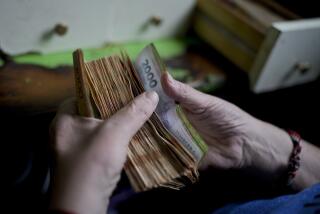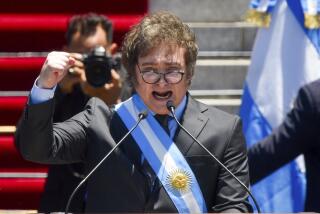Proposed Brazil-Argentina common currency is met with doubts

- Share via
RIO DE JANEIRO — A proposal floated by the leaders of Brazil and Argentina to launch a common currency is being met with deep skepticism by analysts, who say neither country is positioned to tackle such a complicated undertaking or instill confidence in the idea with global markets.
Brazil’s President Luiz Inácio Lula da Silva told reporters Monday, though, that a common currency would reduce a harmful dependence on the U.S. dollar.
“I think this will happen with time, and it is necessary because there are countries that sometimes have difficulty acquiring dollars,” Lula said in Buenos Aires after meeting his Argentine counterpart, Alberto Fernández. “We must not in the 21st century continue doing the same as what was done in the 20th century.”
The currency would initially be shared between Argentina and Brazil for trade and transactions between the two countries and later be adopted by fellow members of the Mercosur trade bloc, Lula explained. Details remained fuzzy a day after Lula and Fernández announced the outlines in a joint statement published Sunday in the Argentine newspaper Perfil.
Speaking in Buenos Aires on Monday afternoon, Brazil’s Finance Minister Fernando Haddad clarified that the proposal would not entail the adoption of a sole currency to replace the Brazilian real and the Argentine peso.
Economists had immediately questioned the logic of the plan between the South American neighbors. Economic conditions are deteriorating in Argentina, where nearly four in 10 people live in poverty. The nation has one of the world’s highest inflation rates — 95% in 2022 — and its peso has been steadily depreciating for over a decade. Its multiple foreign exchange rates include an illegal one employed in backrooms by money-changers — a practice so entrenched that this so-called “blue dollar” rate is published daily in newspapers.
Brazil, Latin America’s largest nation, sits in an objectively better place economically, but it is hardly a beacon of success. Its inflation in 2022 exceeded the ceiling of the central bank’s target range for a second straight year. And the real has shed half its value against the dollar since 2014, just before the nation plunged into its deepest recession in a century. The nation’s growth prospects remain subdued, and it hasn’t recorded a primary budget surplus since 2013.
“Neither country has the initial conditions to make this succeed and attract others,” Mohamed A. El-Erian, former chief executive of Pimco, one of the world’s premier fixed-income investment managers, tweeted on Sunday. “The best this initiative can hope for is that talk creates some political cover for much-needed economic reforms.”
Fernández said neither he nor his Brazilian counterpart knows how a currency could function between their two countries or in the region. But he said they agree that depending on foreign currencies for trade is harmful. The greenback’s recent strength has complicated the repayment of dollar-denominated debt for developing nations around the world, including Argentina. Its central bank uses its precious dollar reserves to pay down its foreign debt and to intervene in the currency market to stem depreciation, and so it is loath to sell greenbacks to importers for trade.
Both countries’ economic teams will present proposals for trade and bilateral transactions, with a currency created after “much debate and meetings,” Lula said.
The proposal isn’t original, nor has it come only from the left.
Lula’s predecessor, Jair Bolsonaro, said during a 2019 visit to Argentina that he and then-President Mauricio Macri were taking a first step toward creating the “peso real.” There have been no signs of advance since then. Three decades earlier, the two countries had approved a proposal to create a common currency for trade known as the “gaucho,” but it was never implemented.
The proposal is “a bad idea” that has merely made for an interesting headline, said Brendan McKenna, an emerging-markets economist and foreign-exchange strategist at Wells Fargo. McKenna suggested that the disparity between the two nations’ economic conditions leaves it no chance of materializing.
“Say that Argentina was in similar place as Brazil — I still don’t think it would work,” McKenna said. “You would need to get a lot of credibility behind this new currency. It took the euro decades to get that credibility.”
Frictions regarding the euro remain to this day, and some investors still don’t want exposure to it despite the euro’s status as a reserve currency in a highly developed region.
“I’m struggling to wrap my head around how this would work for Brazil and Argentina when the Italys and Germanys of the world are still struggling,” McKenna added.
The initiative might be more about politics than economics: Fernández will seek reelection this year, and amid the persistent economic gloom, the idea of a common currency may appeal to potential voters, said Thiago de Aragão, director of strategy at Brasilia-based political risk consultancy Arko Advice.
“Even if they went full-throttle on this, it could take 20 or 30 years. By saying this, [Lula] is supporting Fernández in Argentina, strengthening Fernández in Argentina,” De Aragão said.
As such, this currency may meet a fate similar to the peso real and the gaucho.
“It didn’t seem any less outlandish when I read the details,” said McKenna of Wells Fargo. “It still seemed crazy.”
More to Read
Sign up for Essential California
The most important California stories and recommendations in your inbox every morning.
You may occasionally receive promotional content from the Los Angeles Times.










